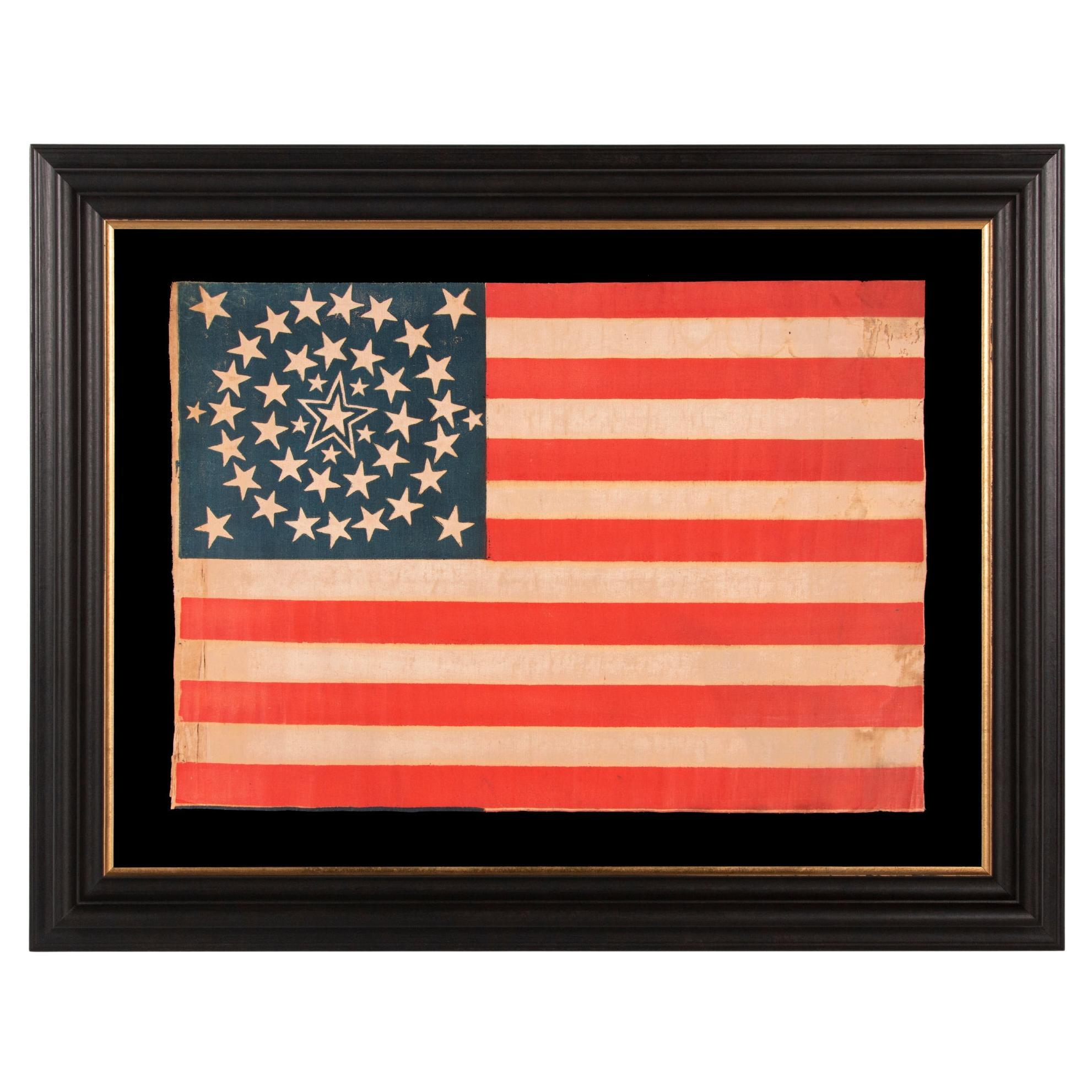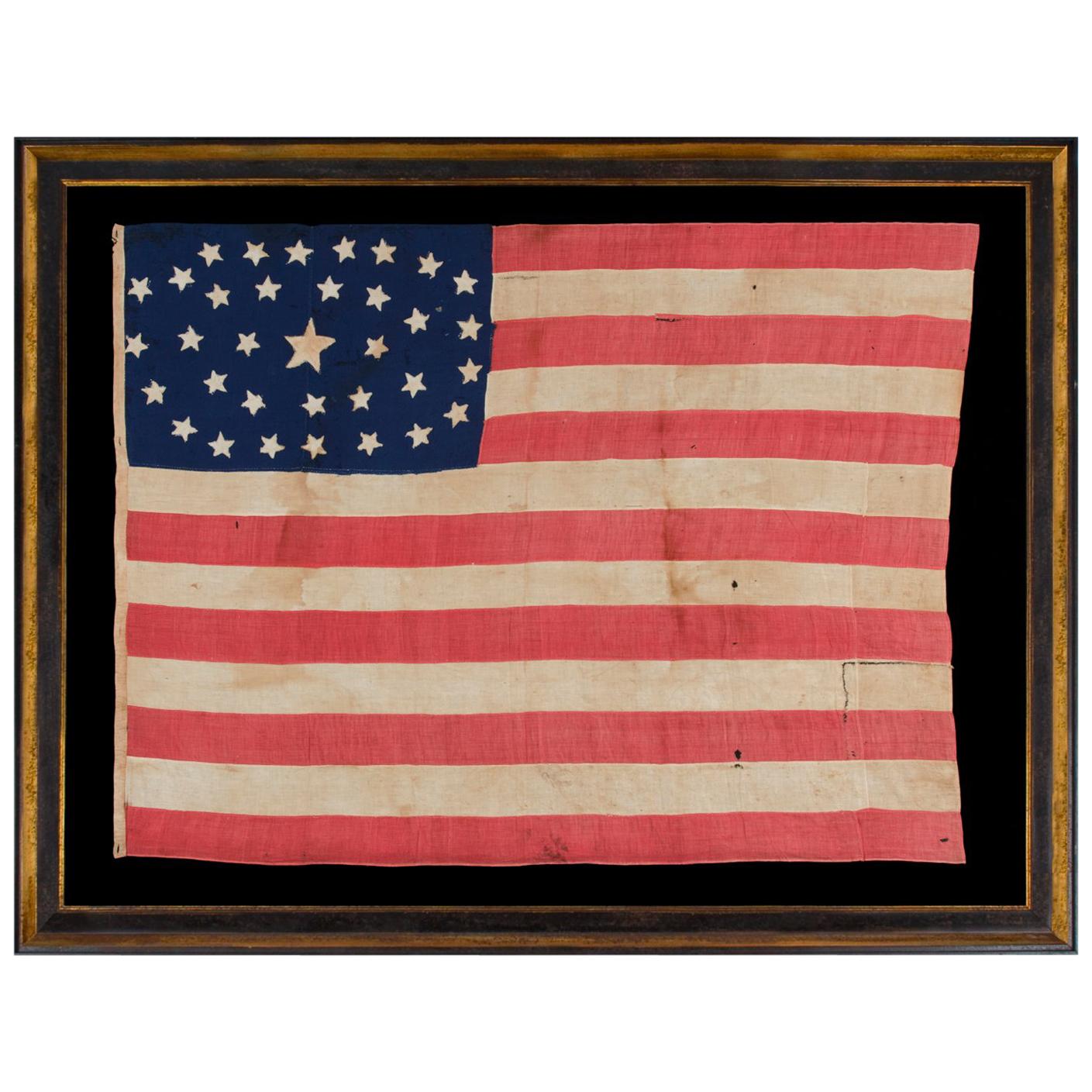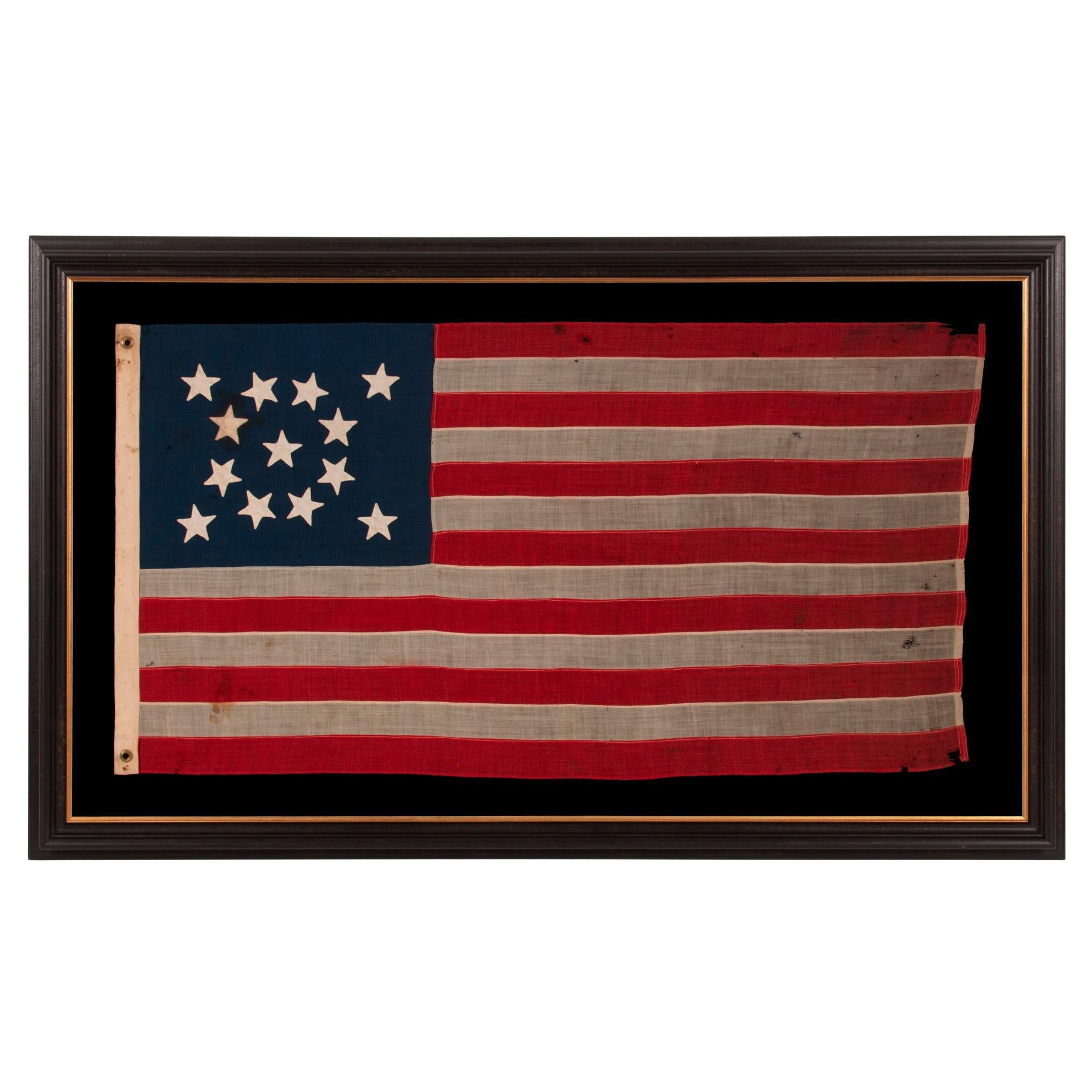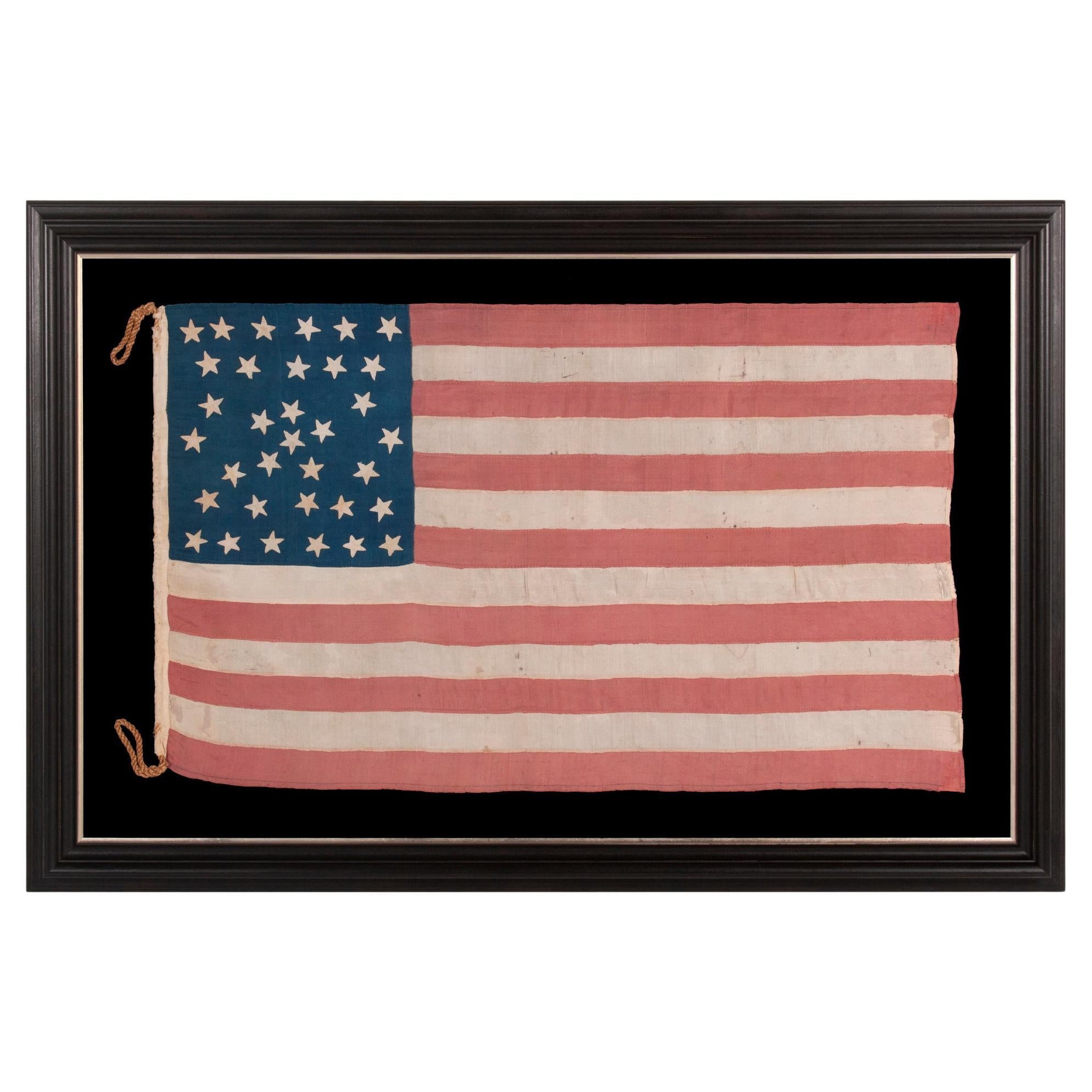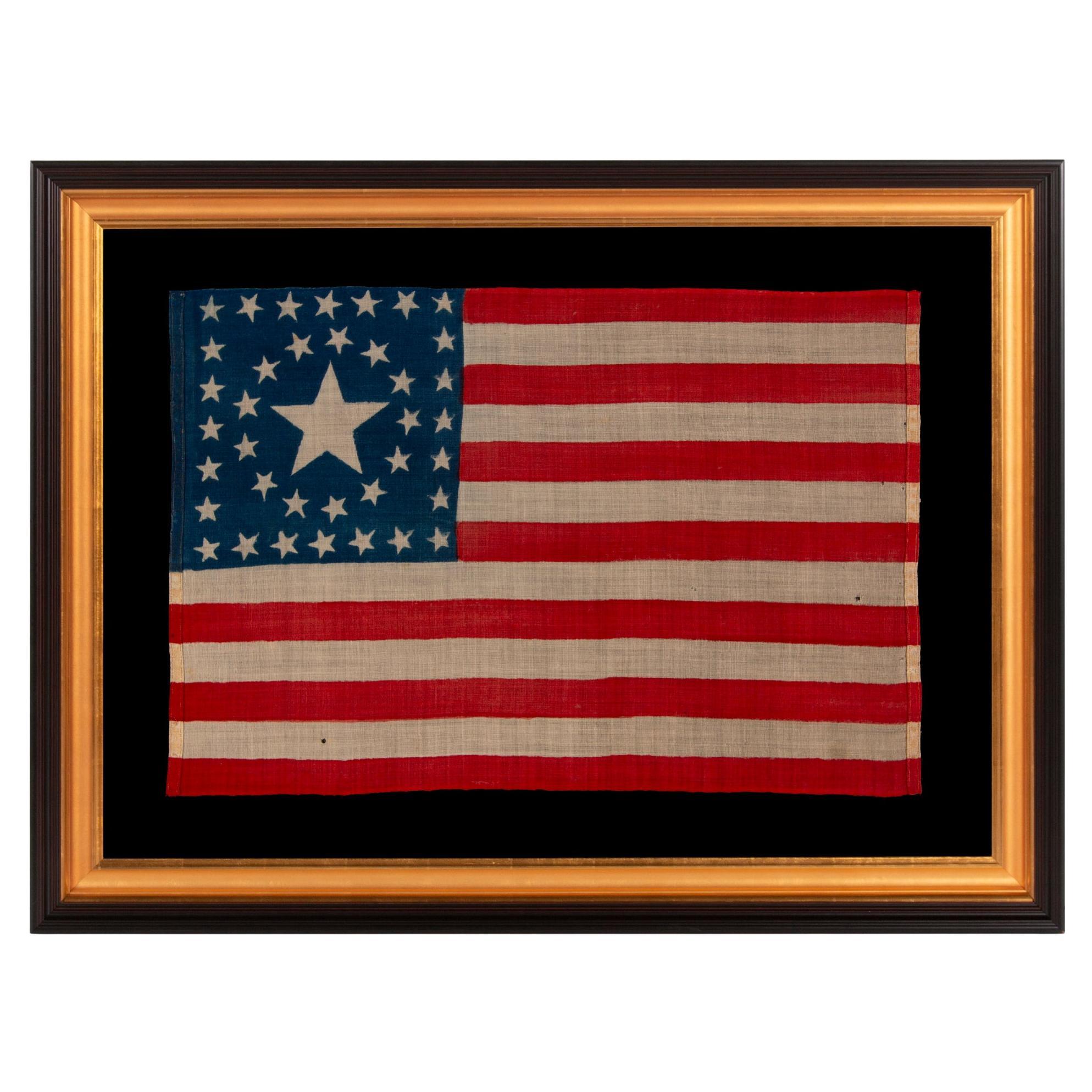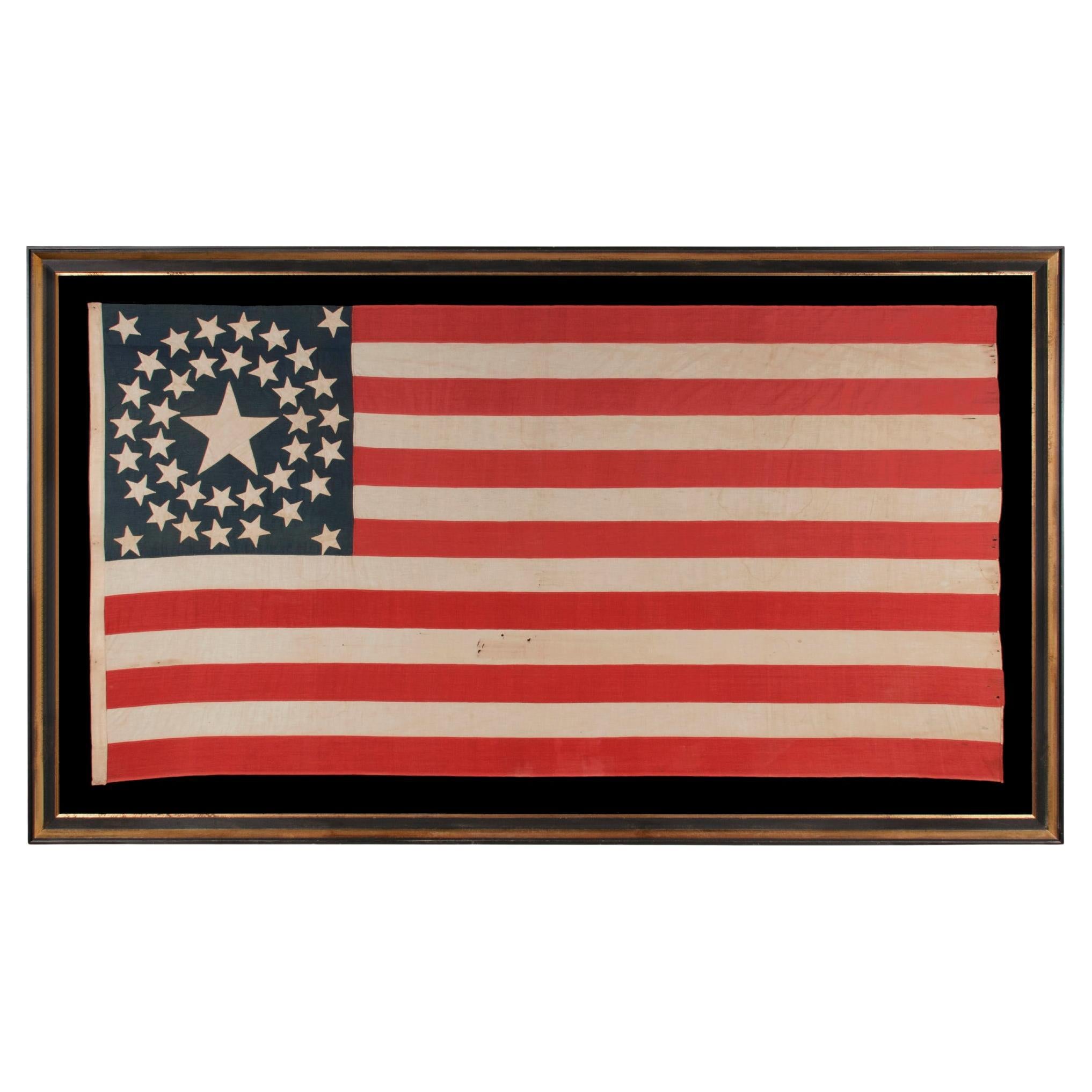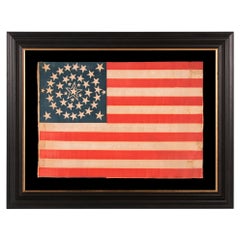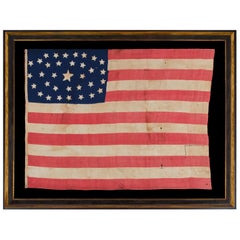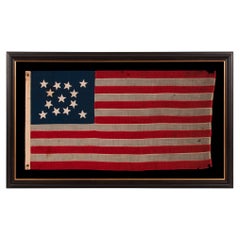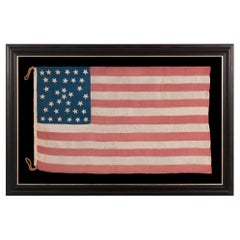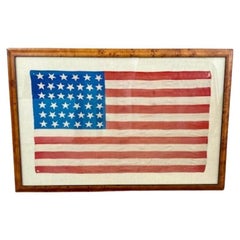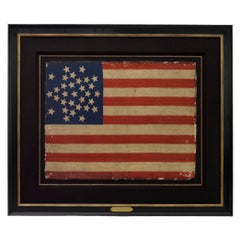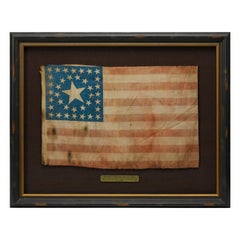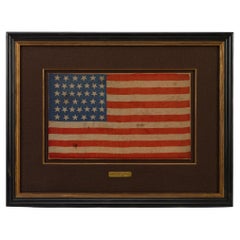Items Similar to 13 Haloed Stars in A Medallion Configuration, ca 1876
Want more images or videos?
Request additional images or videos from the seller
1 of 6
13 Haloed Stars in A Medallion Configuration, ca 1876
Price Upon Request
Price Upon Request
Price Upon Request
Price Upon Request
Price Upon Request
Price Upon Request
Price Upon Request
Price Upon Request
Price Upon Request
Price Upon Request
About the Item
13 HALOED STARS IN A MEDALLION CONFIGURATION, ON AN EXCEPTIONALLY RARE ANTIQUE AMERICAN FLAG MADE FOR THE 1876 CENTENNIAL OF AMERICAN INDEPENDENCE
13 star American parade flag, printed on a blended cotton and wool fabric. Made for the 1876 centennial of American independence, the stars are arranged in what is known as a medallion pattern. This consists of a wreath of 8 stars, surrounding a single, center star, with a star in each corner of the blue canton. Although this was a popular star configuration during the centennial era, this particular variety of 13 star flag is a rare one and I am presently aware of six or fewer in this style to exist.
The design exhibits several unusual and desirable characteristics. One of these is its large scale. At approximately 11 x 15”, most of its counterparts are but a quarter of this size. Even more notable are the stars, themselves, which appear in what is called a "haloed" design, with a thin white line that follows their perimeter. The fabric is also unusual. While known to have been employed in a few other varieties of printed flags, this is the only 13 star variant of any period known to have been produced in this wool & cotton blend.
This style of 13 star flag is known to have been printed alongside another variety of parade flag, in the same size, with 37 stars. I discovered this fact when I encountered 3 of each on the original bolt, uncut, positioned side-by-side. In the 37 star variety, about equally rare among surviving examples, the stars are arranged in an exceptionally rare diamond pattern. While the 37 star flag was still official in 1876, it was well known that at least one more state would be joining the Union that year. This caused most flag-makers to cease production in favor of 38 and 39 star flags. For this reason, 37 star flags were seldom produced for our nation's centennial, where 38 and 39 star counts were preferred, along with 13 star examples to commemorate the original 13 colonies. It is interesting to see 37 star examples that can be so obviously dated to that year specifically.
It is likely that these flags would have been specifically made for the Centennial International Exposition in Philadelphia, our nation's first World’s Fair, which served as the nucleus of the celebration its 100th birthday. Unusually parade flags were printed on cotton or silk, or sometimes even on paper, to be waved or displayed in short-term use at parades, patriotic or political events. Because cotton and paper absorb water, and because silk is not appropriate for long-term exposure to water, these materials are not optimal for long-term outdoor use. The reason for the inclusion of wool was that it sheds water, making it an obvious choice for flags that were to be used outdoors over an extended period. The Centennial Expo lasted for six months and this is the reason that some makers used wool or wool blends in small, decorative flags.
The most notable example of a flag in this exact style was formerly in the collection of Boleslaw and Marie D'Otrange Mastai. An image of its canton appears on page 173 of their landmark text, "The Stars and the Stripes" (Alfred A. Knopf, New York, 1973). The flag was later acquired by my good friend, collector Richard Pierce, and a full image of it appears in his book, "The Stars & The Stripes: Fabric of the American Spirit" (J. Richard Pierce, 2005), p. 29. For many years this was the only known example. During roughly the same period of time there was but one known example of the 37 star, companion variety, which I personally bought and sold and was also in the Pierce collection. Today approximately 6 copies of the 13 star variety are known, all of which I have had the privilege to own.
This particular flag is bound along the hoist, top, and fly with treadle stitching. A treadle-sewn binding of plain weave, white muslin, in the form of an open sleeve, was added along the hoist by a former owner. Along this, near the top, on the obverse (front), there is a black inscription. Bled and faded, this quite clearly includes the letters “T” and “R,” possibly separated by a small “o.” The last letter is illegible. Likely this is the name or initials of a former owner. It was extremely common to mark flags in this manner, during the 19th and early 20th centuries, to indicate ownership.
Mounting: The flag was mounted and framed within our own conservation department, which is led by expert staff. We take great care in the mounting and preservation of flags and have framed thousands of examples.
The background is 100% cotton twill, black in color, that has been washed and treated for colorfastness. The mount was placed in a gilded, distressed molding, to which a more narrow molding with a step-down profile and a surface that is a very dark brown, nearly black, with reddish highlights and undertones, was added as a cap. The glazing is U.V. protective plexiglass. Feel free to inquire for more details.
Condition: There are modest to moderate threadbare areas of loss in the star nearest to the top, hoist end corner, and in the the 2nd, 3rd, 9th, 11th, and 13th stripes, and a couple of minor losses elsewhere. Period fabric, of similar coloration, was placed behind the flag when it was mounted, for masking purposes. There is minor to modest water staining in the upper, fly end corner, and there are minor stains in the center of the flag, in the 8th and 9th stripes, and there is minor soiling elsewhere. The text along the hoist, as previously mentioned, has bled and faded. There is modest fading of the red stripes and blue canton. Many of my clients prefer early flags to show their age and history of use.
- Dimensions:Height: 21 in (53.34 cm)Width: 25.5 in (64.77 cm)Depth: 2 in (5.08 cm)
- Materials and Techniques:
- Place of Origin:
- Period:
- Date of Manufacture:1876
- Condition:See Item Description.
- Seller Location:York County, PA
- Reference Number:Seller: 13j-16531stDibs: LU849742128042
About the Seller
5.0
Recognized Seller
These prestigious sellers are industry leaders and represent the highest echelon for item quality and design.
Established in 1991
1stDibs seller since 2008
70 sales on 1stDibs
Typical response time: 9 hours
- ShippingRetrieving quote...Shipping from: York County, PA
- Return Policy
Authenticity Guarantee
In the unlikely event there’s an issue with an item’s authenticity, contact us within 1 year for a full refund. DetailsMoney-Back Guarantee
If your item is not as described, is damaged in transit, or does not arrive, contact us within 7 days for a full refund. Details24-Hour Cancellation
You have a 24-hour grace period in which to reconsider your purchase, with no questions asked.Vetted Professional Sellers
Our world-class sellers must adhere to strict standards for service and quality, maintaining the integrity of our listings.Price-Match Guarantee
If you find that a seller listed the same item for a lower price elsewhere, we’ll match it.Trusted Global Delivery
Our best-in-class carrier network provides specialized shipping options worldwide, including custom delivery.More From This Seller
View All42 Stars in a Whimsical Medallion Configuration, ca 1889-1890
Located in York County, PA
42 STARS IN A WHIMSICAL MEDALLION CONFIGURATION THAT FEATURES A LARGE, HALOED CENTER STAR AND INCORPORATES 7 TINY STARS; NEVER AN OFFICIAL STAR COUNT, EXCEPTIONALLY RARE, REFLECTS TH...
Category
Antique 1890s North American Political and Patriotic Memorabilia
Materials
Cotton
Price Upon Request
34 Stars in an Outstanding Oval Medallion Configuration, Civil War Period
Located in York County, PA
34 STARS IN AN OUTSTANDING OVAL MEDALLION CONFIGURATION, ON A NARROW CANTON THAT RESTS ON THE 6TH STRIPE, ON A HOMEMADE, ANTIQUE AMERICAN FLAG OF THE CIVIL WAR PERIOD, ENTIRELY HAND-...
Category
Antique 1860s American Political and Patriotic Memorabilia
Materials
Cotton
13 Star Antique American Flag , Hand-Sewn Stars in a Medallion, 1876 Centennial
Located in York County, PA
13 STAR ANTIQUE AMERICAN FLAG WITH A MEDALLION CONFIGURATION OF HAND-SEWN STARS AND A BEAUTIFUL, ELONGATED PROFILE, MADE IN THE ERA OF THE 1876 CENTENNIAL OF AMERICAN INDEPENDENCE, I...
Category
Antique 1870s Political and Patriotic Memorabilia
Materials
Wool
34 Star Antique American Flag with Hourglass Medallion Stars, ca 1861-1863
Located in York County, PA
EXTRAORDINARY 34 STAR ANTIQUE AMERICAN FLAG WITH AN ACCORDION OR HOURGLASS MEDALLION CONFIGURATION THAT SURROUNDS A PENTAGON OF STARS IN THE CENTER; MADE OF FINE SILK AND ENTIRELY HAND-SEWN; MADE DURING THE OPENING YEARS OF THE CIVIL WAR (1861-63), IN A TINY SIZE AMONG ITS COUNTERPARTS OF THE PERIOD; REFLECTS THE ADDITION OF KANSAS AS THE 34TH STATE
34 star flag of the Civil War period with an array of rare, beautiful, and otherwise desirable features. Extremely small among flags of this period with pieced and sewn construction, the flag displays a star pattern that is not only highly unusual, but unique to this particular example. This consists of a single star in the very center, surrounded by a pentagon of stars, flanked by angular bracket of three stars to either side. Above and below are rows of 5 stars, followed by rows of 6 that line the top and bottom of the canton. The resulting configuration is what I have termed an “accordion medallion,” though “hourglass medallion” or “standing bow tie” would be perfectly acceptable.
When rotated 90 degrees, to view the harder-to-identify, bow tie formation, students of early star patterns may note the visual similarity between this and what I call “Starburst” or “Crosshatch” medallions. The pattern, however, conspicuously lacks the crosses of St. Andrew (a saltire) and St. George (roman cross), that would allow it to be more accurately categorized as such.
Entirely hand-sewn, the canton and stripes of the flag are made of fine silk. The hemming of this was accomplished with great skill. The top and bottom edges are selvedge. These are so similar in nature as to have come from the same maker. There is a white, silk binding along the hoist, in the form of an open sleeve, through which a length of braided hemp rope was passed, expertly looped and re-braided into itself at the top and bottom for strength.
The stars are made of white, polished cotton. These were stitched to both sides (double-appliqued). Note how the edges of the fabric were not turned under, providing evidence of the fact that the maker was not especially skilled in appliqueing. This was common, as applique work was far more difficult than producing French seams.
In the 19th century, most flags with pieced and sewn construction were 8 feet long and larger. A six-footer was considered small. Even military battle flags, carried on foot, measured 6’ x 6.5’, which translates into approximately 7’ x 7.5’ after framing, about the size of an average quilt and larger than can comfortably fit on a wall in a house with 8-foot ceilings and average width baseboard. Flags smaller than this were produced both commercially and at home, but the smaller they are, the more unusual they are. At just 26.5 x 46.5 inches, this flag is extremely small for a Civil war period flag with sewn construction.
Silk was both beautiful and lightweight, which made it elegant for military unit colors and preferable for flags meant to be carried on foot. Most outdoor use flags...
Category
Antique 1860s American Political and Patriotic Memorabilia
Materials
Silk
38 Star Rare Circle in A Square Horstmann Brothers Made American Flag, ca 1876
Located in York County, PA
38 STARS IN A RARE AND STRIKING CIRCLE-IN-A-SQUARE MEDALLION, WITH AN ENORMOUS CENTER STAR, MADE FOR THE 1876 CENTENNIAL CELEBRATION BY HORSTMANN BROTHERS OF PHILADELPHIA, A MAJOR MI...
Category
Antique 1870s Political and Patriotic Memorabilia
Materials
Wool
38 Star Antique Flag, Stars in Double Wreath Pattern, Colorado Statehood 1876-89
Located in York County, PA
38 STAR ANTIQUE AMERICAN FLAG WITH A DOUBLE-WREATH CONFIGURATION THAT FEATURES AN ENORMOUS CENTER STAR, REFLECTS THE PERIOD OF COLORADO STATEHOOD, 1876-1889:
38 star American national flag, made entirely of plain weave cotton. The stars are arranged in a medallion configuration. This features an enormous center star, surrounded by two wreaths of much smaller stars, with a flanking star in each corner of the blue canton. The sort of disparity here, present in the scale of the large star, versus those around it, is both exceptionally unusual and graphically dynamic.
Colorado became the 38th state on August 1st, 1876. This was the year of our nation’s centennial. Per the Third Flag Act of 1818, stars were not officially added until the 4th of July following a state's addition. For this reason, 37 remained the official star count for the American flag until part way through the following year. Flag-making was a competitive venture, however, and few flag-makers would have continued to produce 37 star flags when their competitors were making 38’s. Many flag-makers added a 38th star before Colorado entered the Union, in the early part of 1876, or possibly even prior. In fact, many makers of printed flags, called parade flags or hand-wavers, were actually producing flags in the 39 star count, in hopeful anticipation of the addition of two more Western Territories instead of one.
It is for these reasons that 38, 39, and 13 stars, to representing the original 13 colonies, are most often seen on flags displayed at the Centennial International Exhibition. Hosted in Philadelphia, this enormous event was our nation’s first World’s Fair, lasted for a duration of six months, and served as the nucleus of celebrations held to honor America’s 100-year anniversary of independence. The 38 star flag became official on July 4th, 1877 and was generally used until the 39th state was added in November of 1889.
This is probably a homemade flag, though sewn by a very skilled hand, or possibly, by two different individuals. The stripes are pieced and sewn entirely by hand, with remarkable care and precision. The canton is constructed of two lengths of blue fabric, that have been joined with treadle stitching. This was joined to the striped field by hand. The stars are double-appliquéd (applied to both sides) with treadle stitching. There is a treadle-sewn, cotton binding along the hoist, with five, hand-sewn grommets.
It is extremely unusual to encounter this combination of sewing methods. Soon after the sewing machine was mass-marketed, in the mid-1850’s, flag-makers both public and private made good use of treadle machines, to join stripes, when constructing American flags. During the Civil War (1861-65), most stripes were treadle-sewn. Stars were another matter. Until the advent of electric machines...
Category
Antique Late 19th Century American Political and Patriotic Memorabilia
Materials
Cotton
You May Also Like
19th Century American 39 Star Flag, circa 1889
Located in Nantucket, MA
19th Century American 39 Star Flag, circa 1889, a period printed silk parade flag with a wavy pattern of dancing stars. This was never an official flag of the United States but was m...
Category
Antique 1880s American Federal Political and Patriotic Memorabilia
Materials
Silk
31-Star Printed American Flag, Celebrating California Statehood, Circa 1850
Located in Colorado Springs, CO
This is a rare 31-star medallion printed American flag, celebrating the addition of California to the Union. The flag is printed on silk and has a spectacular “Great Star” canton pat...
Category
Antique 1850s American Political and Patriotic Memorabilia
Materials
Silk
38-Star Antique American Flag with Unique Canton, circa 1876-1890
Located in Colorado Springs, CO
This is a striking 38-star American flag. The flag dates to 1876-1890, when Colorado (represented by the large star in the center of the flag’s canton) joined the Union as the 38th s...
Category
Antique Late 19th Century American Political and Patriotic Memorabilia
Materials
Muslin
39-Star Printed American Flag, Commemorating North Dakota Statehood, 1889-1890
Located in Colorado Springs, CO
This is a 39-star unofficial American flag, celebrating North Dakota statehood. The printed flag dates to 1889 and showcases a “whimsical” star pattern in the canton. The flag's cant...
Category
Antique 1880s American Political and Patriotic Memorabilia
Materials
Fabric
38-Star American Parade Flag, Flown at a Reception for President Grant, 1880
Located in Colorado Springs, CO
This is a beautifully colored 38-star American parade flag, flown at a public reception for Ulysses S. Grant in October of 1880. This printed flag features a rare, triple medallion s...
Category
Antique 1880s American Political and Patriotic Memorabilia
Materials
Cotton
45-Star American Flag, Printed on Cotton, Celebrating Utah Statehood, 1896-1908
Located in Colorado Springs, CO
This 45-star United States flag celebrates the statehood of Utah. 45-star flags served as the official American flag from 1896-1908. This particular flag was flown as a parade flag. ...
Category
Antique 1890s American Political and Patriotic Memorabilia
Materials
Cotton
